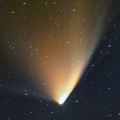
|
It passed the perihelion on Mar. 10, and brightened up to 0-1 mag. Now it is fading. But it is still bright as 3.5 mag (Apr. 2, Carlos Labordena). In the Northern Hemisphere, it will be getting higher gradually in the morning sky. It is not observable in the Southern Hemisphere for a while after this.
Date(TT) R.A. (2000) Decl. Delta r Elong. m1 Best Time(A, h)
Apr. 6 0 29.00 42 40.4 1.317 0.793 36 4.8 4:13 (225, 11)
Apr. 13 0 25.66 50 19.4 1.375 0.941 43 5.5 4:02 (221, 18)
|
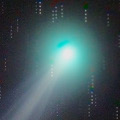
|
It approached to the sun down to 0.73 A.U. on Mar. 24. Now it is brightest, 4.7 mag (Mar. 11, Michael Mattiazzo). Now it locates extremely even in the Southern Hemisphere. In the Southern Hemisphere, it keeps locating low in the morning sky after this. It is not observable now in the Northern Hemisphere. But it becomes observable in May, and it keeps observable in good condition after that while fading gradually.
Date(TT) R.A. (2000) Decl. Delta r Elong. m1 Best Time(A, h)
Apr. 6 0 11.15 -13 11.3 1.588 0.773 22 5.1 4:13 (273,-20)
Apr. 13 0 12.26 -6 53.0 1.634 0.827 24 5.4 4:02 (269,-13)
|
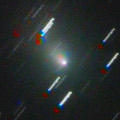
|
Now it is so bright as 10.8 mag (Mar. 29, Marco Goiato). In the Northern Hemisphere, it keeps observable in good condition until April. It locates low in the Southern Hemisphere.
Date(TT) R.A. (2000) Decl. Delta r Elong. m1 Best Time(A, h)
Apr. 6 4 5.34 19 45.2 2.081 1.579 46 12.1 19:51 ( 96, 26)
Apr. 13 4 19.97 16 59.7 2.124 1.553 43 12.0 19:58 ( 96, 21)
|
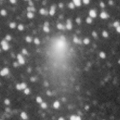
|
Now it is bright as 12.3 mag (Mar. 9, Marco Goiato). It is expected to be observable at 11-13 mag for a long time from 2012 summer to 2013 summer.
Date(TT) R.A. (2000) Decl. Delta r Elong. m1 Best Time(A, h)
Apr. 6 15 14.10 -2 25.5 1.962 2.849 146 12.5 2:18 ( 0, 52)
Apr. 13 15 0.00 1 16.9 1.965 2.902 154 12.6 1:37 ( 0, 56)
|
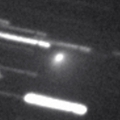
|
New bright comet. Now it is 12.5 mag and visible visually (Mar. 15, Alan Hale). It keeps locating in the morning sky for a long time after this. I will keep the current brightness for a long time.
Date(TT) R.A. (2000) Decl. Delta r Elong. m1 Best Time(A, h)
Apr. 6 21 57.98 2 31.5 1.965 1.450 45 12.6 4:13 (279, 16)
Apr. 13 22 18.63 3 54.6 1.976 1.479 46 12.7 4:02 (277, 16)
|

|
It brightened up to 11-12 mag in 2012. Now it is 12.3 mag (Mar. 23, Marco Goiato). It will be observable at 12-13 mag in good condition again in 2013.
Date(TT) R.A. (2000) Decl. Delta r Elong. m1 Best Time(A, h)
Apr. 6 14 44.65 -15 44.0 4.877 5.784 152 12.8 1:49 ( 0, 39)
Apr. 13 14 36.21 -15 16.9 4.848 5.808 161 12.8 1:13 ( 0, 40)
|

|
It brightened rapidly, and reached up to 12 mag in 2012. It is bright as 12.2 mag still now (Mar. 23, Marco Goiato). It keeps 12-14 mag until autumn. It locates somewhat low in the Northern Hemisphere.
Date(TT) R.A. (2000) Decl. Delta r Elong. m1 Best Time(A, h)
Apr. 6 19 28.62 -25 10.9 2.792 2.903 86 13.3 4:13 (326, 22)
Apr. 13 19 35.87 -25 29.9 2.703 2.908 91 13.2 4:02 (329, 22)
|
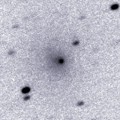
|
Now it is visible visually at 12.5 mag (Mar. 23, Marco Goiato).
Date(TT) R.A. (2000) Decl. Delta r Elong. m1 Best Time(A, h)
Apr. 6 14 0.55 -23 54.4 5.289 6.223 157 13.6 1:04 ( 0, 31)
Apr. 13 13 57.42 -23 43.6 5.255 6.222 163 13.6 0:34 ( 0, 31)
|
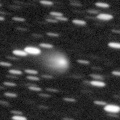
|
Now it is 13.7 mag (Jan. 11, Hiroshi Abe). It keeps bright at 13-14 mag for a long time until 2014. It keeps observable for a long time in the Northern Hemisphere. It will be observable also in the Southern Hemisphere after April.
Date(TT) R.A. (2000) Decl. Delta r Elong. m1 Best Time(A, h)
Apr. 6 21 19.66 30 32.0 6.396 5.908 56 13.6 4:13 (256, 38)
Apr. 13 21 20.04 30 51.4 6.329 5.906 60 13.6 4:02 (257, 42)
|
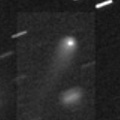
|
It keeps 13 mag and observable in good condition in the Northern Hemisphere for a long time from 2013 to 2014. Now it is 14.5 mag (Mar. 4, Sandor Szabo). It locates extremely low in the Southern Hemisphere.
Date(TT) R.A. (2000) Decl. Delta r Elong. m1 Best Time(A, h)
Apr. 6 9 32.98 49 14.0 3.768 4.195 108 14.1 20:33 (180, 76)
Apr. 13 9 24.13 49 41.0 3.844 4.161 101 14.1 19:58 (179, 75)
|
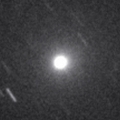
|
Now it is so bright as 11.8 mag (Mar. 9, Carlos Labordena). It will be fading gradually after this.
Date(TT) R.A. (2000) Decl. Delta r Elong. m1 Best Time(A, h)
Apr. 6 9 40.82 21 30.0 1.207 1.951 123 14.1 20:42 ( 0, 76)
Apr. 13 9 43.70 19 9.6 1.261 1.951 118 14.2 20:17 ( 0, 74)
|
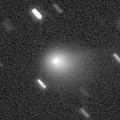
|
It brightened up to 9.0 mag in 2012 autumn (Nov. 4, Juan Jose Gonzalez). However, it faded out unexpectedly around the perihelion passage. It was expected to be 9-10 mag, but actually, it is much fainter as 13.9 mag (Mar. 20, Hidetaka Sato). In the Southern Hemisphere, it keeps observable in good condition while fading slowly after this. In the Northern Hemisphere, it is hardly observable after 2013.
Date(TT) R.A. (2000) Decl. Delta r Elong. m1 Best Time(A, h)
Apr. 6 23 26.23 -43 9.9 2.560 2.129 53 14.2 4:13 (306,-26)
Apr. 13 23 50.12 -43 11.3 2.561 2.175 56 14.3 4:02 (306,-27)
|
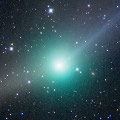
|
It kept as bright as 6-7 mag for a long time from 2011 summer to 2012 spring. Now it is fading. But it is bright as 15.2 mag still now (Mar. 4, Sandor Szabo).
Date(TT) R.A. (2000) Decl. Delta r Elong. m1 Best Time(A, h)
Apr. 6 8 11.16 -8 21.7 5.110 5.511 108 14.5 19:51 ( 14, 46)
Apr. 13 8 9.56 -8 2.8 5.275 5.572 102 14.6 19:58 ( 26, 43)
|

|
Big asteroid discovered in 1906. It suddenly showed the cometary activity on Dec. 11, 2010, probably due to an impact of a small object. It has already turned to be stellar. Appearing in the morning sky again in the Southern Hemisphere.
Date(TT) R.A. (2000) Decl. Delta r Elong. m1 Best Time(A, h)
Apr. 6 23 5.08 -18 7.9 3.510 2.782 37 14.6 4:13 (286, -9)
Apr. 13 23 15.93 -17 17.8 3.466 2.794 41 14.6 4:02 (286, -8)
|
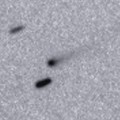
|
Now it is 15.9 mag (Mar. 15, J. Gonzalez). It keeps bright as 13-14 mag for a long time from 2013 to 2014. It is a bit fainter than this ephemeris recently.
Date(TT) R.A. (2000) Decl. Delta r Elong. m1 Best Time(A, h)
Apr. 6 14 45.06 -10 53.1 2.560 3.485 153 14.8 1:49 ( 0, 44)
Apr. 13 14 41.18 -10 43.2 2.506 3.470 161 14.7 1:17 ( 0, 44)
|
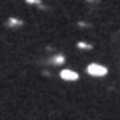
|
Now it is 14.9 mag (Mar. 4, Jakub Cerny). Already visible visually. It is expected to be a great comet in 2013 autumn when the comet approaches to the sun down to only 0.01 A.U. It keeps visible with naked eyes from November to January, and can be extremely bright as Venus or more at the highlight. The condition is excellent in the Northern Hemisphere. It keeps observable almost all through the period of brightening, at the highlight, and of fading. The condition is not good in the Southern Hemisphere. It is not observable at all the latter part of the highlight, and it keeps low all through the period.
Date(TT) R.A. (2000) Decl. Delta r Elong. m1 Best Time(A, h)
Apr. 6 6 37.20 30 23.8 4.220 4.199 81 14.9 19:51 ( 90, 62)
Apr. 13 6 37.40 30 8.2 4.256 4.115 75 14.8 19:58 ( 94, 55)
|
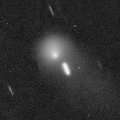
|
Now it is 14.7 mag (Feb. 3, Jakub Cerny). It will be fading slowly after this. But it keeps 15 mag in 2013. It is observable in good condition in the Southern Hemisphere. It is not observable now in the Northern Hemisphere.
Date(TT) R.A. (2000) Decl. Delta r Elong. m1 Best Time(A, h)
Apr. 6 3 15.41 -31 5.7 7.005 6.401 49 14.8 19:51 ( 61,-13)
Apr. 13 3 19.13 -30 4.0 7.059 6.427 47 14.8 19:58 ( 65,-18)
|
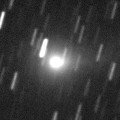
|
Long-lost comet for almost 200 years since 1827. Finally re-discovered by Rob Matson from SWAN images of mid November. Now it is 12.2 mag (Mar. 16, Katsumi Yoshimoto). In the Northern Hemisphere, it keeps observable in excellent condition while fading after this. In the Southern Hemisphere, it keeps locating extremely low after this.
Date(TT) R.A. (2000) Decl. Delta r Elong. m1 Best Time(A, h)
Apr. 6 14 33.38 54 14.4 1.305 1.965 116 14.8 1:39 (180, 71)
Apr. 13 13 36.53 54 45.4 1.405 2.056 116 15.4 0:15 (180, 70)
|
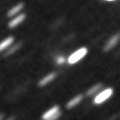
|
Now it is 15.3 mag (Mar. 4, Toshiyuki Takahashi). It will brighten up to 12 mag from summer to autumn. In the Northern Hemisphere, it is observable only until spring when the comet brightens up to 15 mag. In the Southern Hemisphere, it keeps unobservable until August. Then it keeps observable while fading gradually.
Date(TT) R.A. (2000) Decl. Delta r Elong. m1 Best Time(A, h)
Apr. 6 2 28.78 42 12.9 2.972 2.311 40 15.0 19:51 (129, 19)
Apr. 13 2 46.19 41 6.5 2.964 2.243 36 14.9 19:58 (129, 16)
|
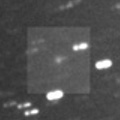
|
Now it is 15.8 mag, brighter than expected (Feb. 4, Hidetaka Sato). It reaches up to 15 mag from spring to summer. It is observable in excellent condition in the Southern Hemisphere. It locates low in the Northern Hemisphere.
Date(TT) R.A. (2000) Decl. Delta r Elong. m1 Best Time(A, h)
Apr. 6 15 38.51 -47 49.4 2.687 3.380 126 15.1 2:43 ( 0, 7)
Apr. 13 15 19.42 -46 35.3 2.586 3.372 135 15.0 1:56 ( 0, 8)
|

|
It reached up to 12 mag from autumn to winter. Now it is fading, but still bright as 14.3 mag (Mar. 5, Mitsunori Tsumura). It is not observable in the Southern Hemisphere. It will be unobservable soon also in the Northern Hemisphere.
Date(TT) R.A. (2000) Decl. Delta r Elong. m1 Best Time(A, h)
Apr. 6 2 42.96 17 46.8 4.217 3.363 27 15.3 19:51 (106, 9)
Apr. 13 2 53.81 17 51.1 4.284 3.386 23 15.4 19:58 (109, 4)
|
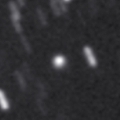
|
Now it is 16.1 mag (Mar. 18, Catalina Sky Survey). It is expected to brighten up to 5-6 mag in 2014 autumn. In 2013, it keeps observable in good condition until autumn when it brigthens up to 13-14 mag.
Date(TT) R.A. (2000) Decl. Delta r Elong. m1 Best Time(A, h)
Apr. 6 17 28.47 15 19.0 5.717 6.131 109 15.7 4:13 (347, 70)
Apr. 13 17 25.51 16 10.3 5.569 6.069 115 15.6 4:01 ( 0, 71)
|
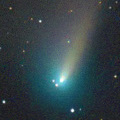
|
It approached to the earth down to 0.3 A.U. and brightened up to 7-8 mag from late December to early January. However, it will go away from the earth and fade out rapidly after this. It has already faded down to 15.3 mag (Mar. 3, Mitsunori Tsumura). It keeps observable in good condition in the Southern Hemisphere after this. It will be unobservable soon in the Northern Hemisphere.
Date(TT) R.A. (2000) Decl. Delta r Elong. m1 Best Time(A, h)
Apr. 6 4 41.85 -18 23.1 2.543 2.220 60 16.0 19:51 ( 59, 11)
Apr. 13 4 48.86 -18 46.6 2.681 2.300 57 16.3 19:58 ( 63, 5)
|
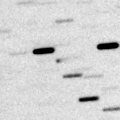
|
Now it is 16.2 mag (Feb. 16, Ken-ichi Kadota). It keeps observable at 16 mag in the morning sky from February to April.
Date(TT) R.A. (2000) Decl. Delta r Elong. m1 Best Time(A, h)
Apr. 6 20 28.92 -10 10.4 1.647 1.598 69 16.1 4:13 (304, 25)
Apr. 13 20 45.50 -9 10.8 1.619 1.619 71 16.2 4:02 (304, 26)
|
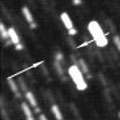
|
Now it is 16.1 mag (Mar. 4, Hidetaka Sato). In the Southern Hemisphere, it will be observable at 15-16 mag in good condition for a long time until summer. It is not observable at all in the Northern Hemisphere.
Date(TT) R.A. (2000) Decl. Delta r Elong. m1 Best Time(A, h)
Apr. 6 3 1.93 -53 2.7 4.700 4.368 64 16.3 19:51 ( 42,-26)
Apr. 13 3 13.85 -51 33.4 4.727 4.396 64 16.3 19:58 ( 45,-28)
|
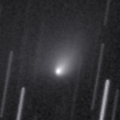
|
It brightened up to 13.7 mag and became visible visually in winter (Dec. 23, Juan Jose Gonzalez). Now it is fading. It has already faded down to 16.7 mag (Mar. 4, Toshiyuki Takahashi). It locates low in the Southern Hemisphere. It will be too low in the evening in late April also in the Northern Hemisphere.
Date(TT) R.A. (2000) Decl. Delta r Elong. m1 Best Time(A, h)
Apr. 6 4 43.66 23 22.4 2.951 2.537 56 16.4 19:51 ( 95, 36)
Apr. 13 4 51.66 21 41.0 3.081 2.573 51 16.5 19:58 ( 97, 30)
|
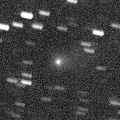
|
It brightened up to 15.5 mag in 2012 summer. Although it has already passed the perihelion, it tends to become brightest after the perihelion passage. It will be observabel at 16 mag again in 2013 summer. Appearing in the morning sky, but it has not been observed yet.
Date(TT) R.A. (2000) Decl. Delta r Elong. m1 Best Time(A, h)
Apr. 6 21 41.09 -19 13.0 3.897 3.426 55 16.5 4:13 (299, 6)
Apr. 13 21 49.20 -18 49.0 3.829 3.440 60 16.5 4:02 (300, 8)
|
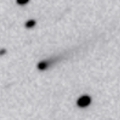
|
Now it is 15.9 mag (Mar. 15, P. C. Sherrod). It will be observable at 16-17 mag for a long time from 2013 to 2014.
Date(TT) R.A. (2000) Decl. Delta r Elong. m1 Best Time(A, h)
Apr. 6 11 57.91 6 29.2 2.918 3.873 159 16.5 22:58 ( 0, 61)
Apr. 13 11 54.63 6 35.7 2.950 3.867 152 16.5 22:27 ( 0, 62)
|

|
Now it is 16.8 mag (Mar. 31, Siding Spring Survey). It keeps 16 mag and observable in good condition until July.
Date(TT) R.A. (2000) Decl. Delta r Elong. m1 Best Time(A, h)
Apr. 6 19 33.50 -22 55.0 2.195 2.328 84 16.9 4:13 (324, 23)
Apr. 13 19 34.02 -19 52.7 2.065 2.311 91 16.7 4:02 (326, 27)
|
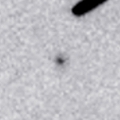
|
It is expected to brighten up to 11 mag and become observable in excellent condition in 2014 spring. Now it is 16.7 mag (Mar. 12, P. C. Sherrod). In the Northern Hemisphere, it keeps observable in good condition until early summer. It locates low in the Southern Hemisphere.
Date(TT) R.A. (2000) Decl. Delta r Elong. m1 Best Time(A, h)
Apr. 6 8 32.57 41 0.3 3.789 4.129 102 17.1 19:51 (151, 83)
Apr. 13 8 32.19 40 57.4 3.827 4.064 96 17.0 19:58 (123, 78)
|
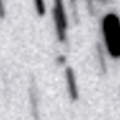
|
Now it is 17.8 mag (Mar. 24, Hidetaka Sato). It is expected to brighten up to 14 mag in July and August. In the Southern Hemisphere, it keeps observable for a long time until the comet fades out. It keeps observable in good condition until September also in the Northern Hemisphere.
Date(TT) R.A. (2000) Decl. Delta r Elong. m1 Best Time(A, h)
Apr. 6 21 53.74 23 47.4 3.401 2.829 47 17.2 4:13 (260, 29)
Apr. 13 21 57.72 23 33.4 3.295 2.786 51 17.0 4:02 (261, 31)
|
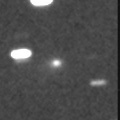
|
Now it is 16.5 mag (Mar. 12, P. C. Sherrod). It keeps observable in good condition at 17 mag until June. It locates somewhat low in the Southern Hemisphere.
Date(TT) R.A. (2000) Decl. Delta r Elong. m1 Best Time(A, h)
Apr. 6 9 3.88 22 15.3 1.334 1.984 115 17.1 20:05 ( 0, 77)
Apr. 13 9 10.24 21 56.2 1.388 1.974 110 17.2 19:58 ( 15, 76)
|
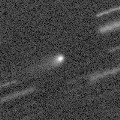
|
Now it is 17.3 mag (Mar. 16, Catalina Sky Survey). It brightened up to 16.5 mag in 2012. It will be observable in good condition again at 17.5 mag in 2013 spring.
Date(TT) R.A. (2000) Decl. Delta r Elong. m1 Best Time(A, h)
Apr. 6 13 17.61 7 56.7 5.111 6.083 165 17.4 0:22 ( 0, 63)
Apr. 13 13 9.59 8 28.3 5.140 6.102 162 17.4 23:41 ( 0, 63)
|

|
First return of a new periodic comet discovered in 2005. It will be observable at 17 mag for a long time from 2013 to 2014. However, it has not been recovered yet. Not it is fainter than 19.5 mag (Feb. 21, Martin Masek).
Date(TT) R.A. (2000) Decl. Delta r Elong. m1 Best Time(A, h)
Apr. 6 17 22.14 -14 13.7 2.764 3.315 115 17.6 4:13 (356, 41)
Apr. 13 17 23.47 -14 0.9 2.669 3.307 121 17.5 3:59 ( 0, 41)
|

|
It was observed around 20 mag in 2012 spring. But it has not been observed recently. It will be observable at 17.5 mag from spring to summer.
Date(TT) R.A. (2000) Decl. Delta r Elong. m1 Best Time(A, h)
Apr. 6 18 16.62 -22 10.1 2.223 2.626 102 17.6 4:13 (342, 31)
Apr. 13 18 21.78 -21 31.5 2.141 2.629 107 17.6 4:02 (345, 32)
|
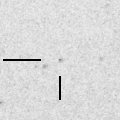
|
Now it is 17.9 mag (Feb. 10, Hidetaka Sato). It keeps observable in good condition at 17 mag from spring to summer.
Date(TT) R.A. (2000) Decl. Delta r Elong. m1 Best Time(A, h)
Apr. 6 18 35.50 -14 28.2 2.593 2.897 97 17.7 4:13 (334, 37)
Apr. 13 18 41.04 -13 38.3 2.506 2.897 102 17.6 4:02 (337, 38)
|
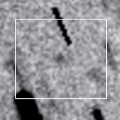
|
It was predicted to be already 16-17 mag. But actually, it is 21.2 mag, much fainter than predicted by 4 mag (Mar. 15, Jean-Francois Soulier). It was expected to brighten up to 14 mag and to be observable in excellent condition in summer. However, it can be fainter than 18 mag.
Date(TT) R.A. (2000) Decl. Delta r Elong. m1 Best Time(A, h)
Apr. 6 15 22.41 0 57.0 1.147 2.041 143 20.5 2:26 ( 0, 56)
Apr. 13 15 22.53 1 41.5 1.078 2.005 148 20.2 1:59 ( 0, 57)
|
|
![]()
 C/2012 X1 ( LINEAR )
C/2012 X1 ( LINEAR ) C/2012 S3 ( PanSTARRS )
C/2012 S3 ( PanSTARRS ) 175P/Hergenrother
175P/Hergenrother C/2010 R1 ( LINEAR )
C/2010 R1 ( LINEAR ) P/2005 L1 ( McNaught )
P/2005 L1 ( McNaught ) 91P/Russell 3
91P/Russell 3 P/2012 F2 ( PanSTARRS )
P/2012 F2 ( PanSTARRS ) 98P/Takamizawa
98P/Takamizawa![]()

































